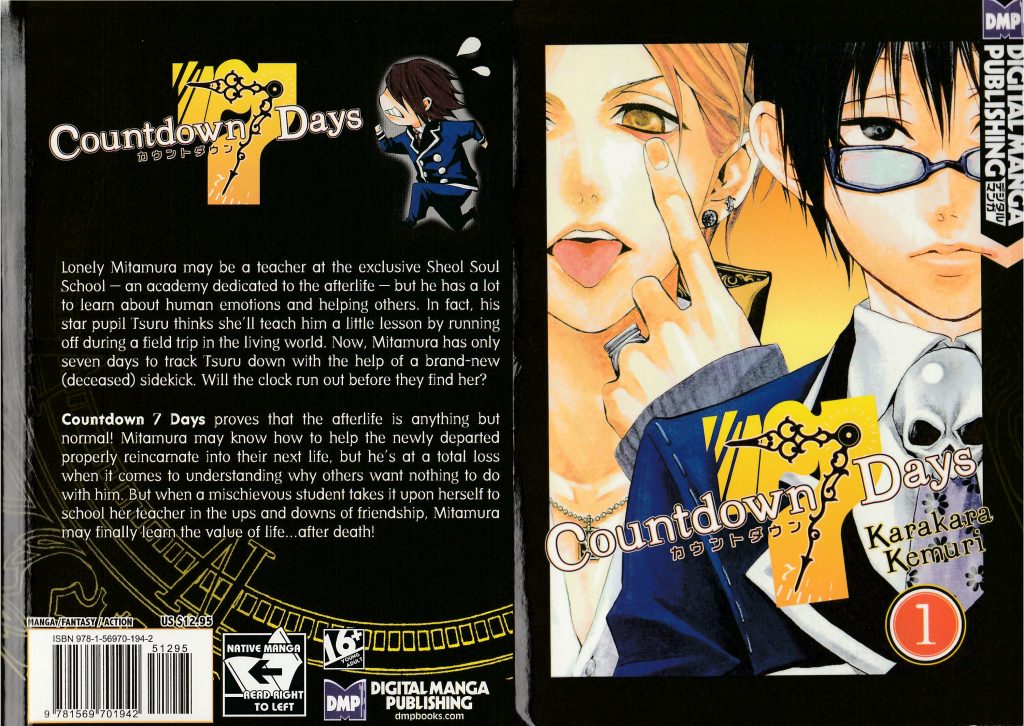





****
Countdown 7 Days is a Supernatural Josei manga by Karakara Kemuri. It’s a four volume manga that ran from June 2009 through December 2010 in the Shojo monthly, Comic Avarus. It was published in english by the Digital Publishing Manga Company from May 2011 to September 2012 before being dropped.
Countdown 7 Days follows a spirit teacher, Mitamura, from Sheol Soul School. The school educates those who have recently died on necessary skills to help acclimate them to the afterlife. Tsuru, his top student has earned a field trip to the living world and handily decides to run off the first chance she gets. Mitamura now has to find her and bring her back to Sheol before the hard limit of seven days is over.

I must admit, I’m not sure what I was on when I was in the comic shop picking this up because I either didn’t read the back cover summary or I didn’t internalize it in any meaningful fashion. The summary isn’t wrong, it just strikes me as way too direct. It hands out the main thematic conceits of the story – something that one should be able to grok from the story itself. Try this summary on for size.
“Mitamura is a teacher at Sheol Soul School. But life for Mitamura is a lonely one. His assistant despises him, his students don’t like him and his supervisor is exsaperated with him. Now his top pupil runs off during a field trip to the land of the living. To make things worse, he picks up another soul he has to be responsible for. Can this unlikely duo find the lost student in time? And can they figure out why she ran off in the first place?”
Doesn’t that sound a little better? I’d think so, but perhaps the heavier focus on the theme and, by extension, Mitamura’s central character flaw may be for the best – it appears it’s going to be the most enduring aspect of the story so far.
I’ll be straight with you – Countdown is the shortest manga in the ATM series so far (I know, this is only the third entry, but give me a break, ok?). Of the entries we’ve seen, Countdown clocks in at 133 pages and 3 sections. This manga closes at a point where Alice in Murderland and Cat Paradise would just be opening their final chapters and it’s already wrapping up the resolution to it’s advertised premise by the time the other two have just finished establishing theirs.
Now don’t get me wrong, it isn’t necessarily a bad thing. It’s more of a double edged sword. They front-loaded their manga with a temporary conflict to introduce all of the characters and their world. Furthermore, the narrative is charitable enough to wrap up a premise that didn’t have the meat to carry the series more than a volume or two. That being said, I did find myself checking the cover and the table of contents multiple times during the first 50 or so pages to make sure that there was indeed a 1 printed on the cover and that this was indeed part of a series of books. The story is full of cartoony, matter of fact, slapstick humor. But you also have this breakneck pace later on in section 1. So you have these zany schemes and Mitamura’s (sometimes) comedic sociopathy filling the days that start flying by at a blistering pace (like a day every few pages). The combination of those two with high personal stakes for the main characters (death, losing a shot at reincarnation, turning into an evil spirit) and reading this feels like a jarring plot whirlpool. The resolution relieves this anxiety, but it’s still weird initially.
Part of Countdown’s ……er, compactness is it’s modest cast of characters. Volume 1 introduces us to Mitamura, Mitsuhide, the department head, Tsuru and Honasuke.
Mitamura is a Sheol teacher and main protagonist. He is rather cold to the people around him and has, if not outright offended, failed to befriend any of his colleagues. He doesn’t mean to, though. He seems somewhat sociopathic, just not understanding and connecting with others emotionally. He risks termination, figuratively and literally if he doesn’t catch Tsuru.
Tsuru is the top student under the care of Mitamura. She despises his coldness and runs off on the field trip to the living world. Due to her being an existing spirit registered at Sheol Sould School, she risks being turned into an evil spirit after 7 days instead of being returned to Sheol.
Hanasuke is a recently deceased 23 year old guy Mitamura runs over and ropes into helping him. He’s operating on the promise that Mitamura will reincarnate him in exchange for finding Tsuru. Unlike Tsuru, he’s a fresh face in the spirit world so an automated system will open a portal and pull him into Sheol automatically in seven days, thus ruining his chances at being brought back to life.
Mitsuhide is a fellow teacher and Mitamura’s assistant at school. Fed up with his coldness, he elects to find Tsuru first, thus ensuring Mitamura’s firing and death.
The department head is the boss of both Mitamura and Mitushide. He offers advice to Mitamura and is exasperated with his antics, but does seem genuinely interested in helping him change for the better.
Mitamura– Don’t get me wrong here. I’m not giving a full throated endorsement of Mitamura as a character I like or as a likable character, even. What I DO like, however, is how the story treats him. While his sociopathy may enable some of the slapstick humor, by no means, is it considered a source of humor. Mercy killing a wounded animal brought to you for help isn’t funny. Lying to someone about their mortality isn’t funny either. It’s downright cruel on the surface. He doesn’t want hurt other people’s feelings, but he does so because he doesn’t understand, much less consider, them when he’s trying to get his work done.
Thematic consistency – If MAL is anything to go by, the mangaka is known for her emotionally resonant characters. Truthfully the most satisfying part of Countdown would be it’s emotional core. There’s a good share of humor, but it’s serious business once someone mentions their feelings. Furthermore, one of the characters’ appearance changes drastically half way through the volume. They handwave this by referring to the two different worlds having different time tables. That’s not an inconsistency as one can easily infer that, in at least one of the worlds, your appearance may be dependent on what you were like when you got there. Regardless, their appearance in part 1 is indicative of an event that had a profound effect upon them and synergizes with their emotional state at the time.
Part 1 – Part 1 is full of shenanigans and goofiness and people getting hit with scooters and – did we mention that some people’s lives are also at stake? Part 1 is essentially an extended prologue. It places all of the relevant players on the board, but the slapstick shtick can make it hard to know how much of this one is supposed to take seriously. Once it starts its resolution, it really treats its premise as serious business, does a badass thing or two and is then on its way. It’s not horrible, but it’s a bit jarring. It’s like the story coasted on neutral for a while, disengaged the clutch, revved up and then re-engaged directly on 3rd or 4th gear. It goes from “are we gonna do anything” to “OH SHIT. We’re doing the thing and we’re doing it RIGHT NOW” real quick. You’re then immediately greeted with a breather and a fresh chance at a new conflict and all is well.
I’m torn. I’m torn between the weirdness I felt in part 1 and the payoff I got going into part 2. The first 40 or so pages got a few chuckles out of me, but I couldn’t shake the feeling that we weren’t going anywhere when we rightfully should’ve been. I’m hoping that the pacing and issues of part 1 don’t continue into the next arc, but that the emotional high notes and character development does.
Continue?:



